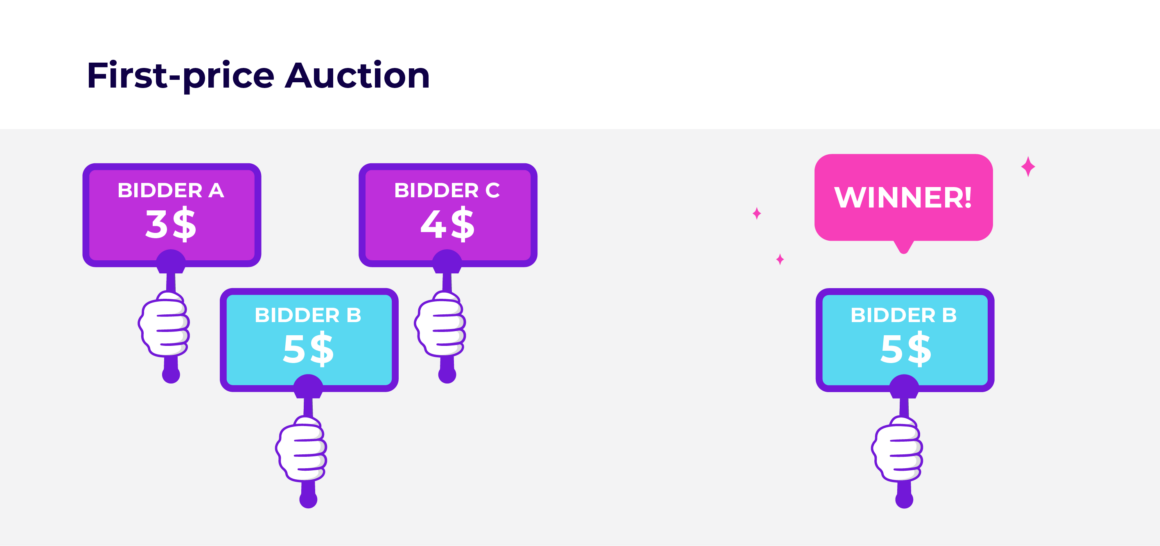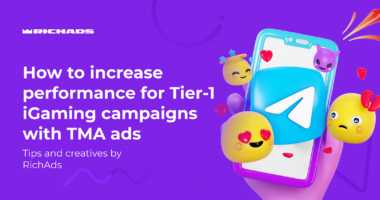Programmatic advertising is definitely the biggest innovation in digital marketing over the last few years. Step by step it changed the entire world of advertising. You’ve definitely come across terms such as Header Bidding and Real Time-Auction – you have to be aware that they made new challenges in the programmatic world.
While you are starting your adventure with the RTB software you need to know that there are two key types of auctions: first-price and second-price.
So let’s dive deeper into the difference between them and why first-price auctions are getting more and more popular.
What is the First-Price Auction?
In the simplest terms, both auctions select the highest bidder as the winner of the auction. Makes sense, we want to choose the guy who wants to pay us the most. The difference comes when it’s time to paying. In the first-price auction, the winner pays us what they offered as their bid.
The type of auction gives a lot of transparency, advertisers know exactly how much they will pay for 1000 impressions and publishers know how much they will get. Thanks to this, it’s much easier to estimate expenses and incomes and plan a long-term strategy.
First-Price Auction Example:
We have three advertisers taking part in the real-time auction. Each of them declares how much they are able to pay for 1000 impressions:
Alex offers $5
John offers $3
Chris offers $4
The highest bid offer is Alex and he is the winner of the auction. Alex will pay exactly $5 per 1 000 impressions to the publisher/ad exchange.
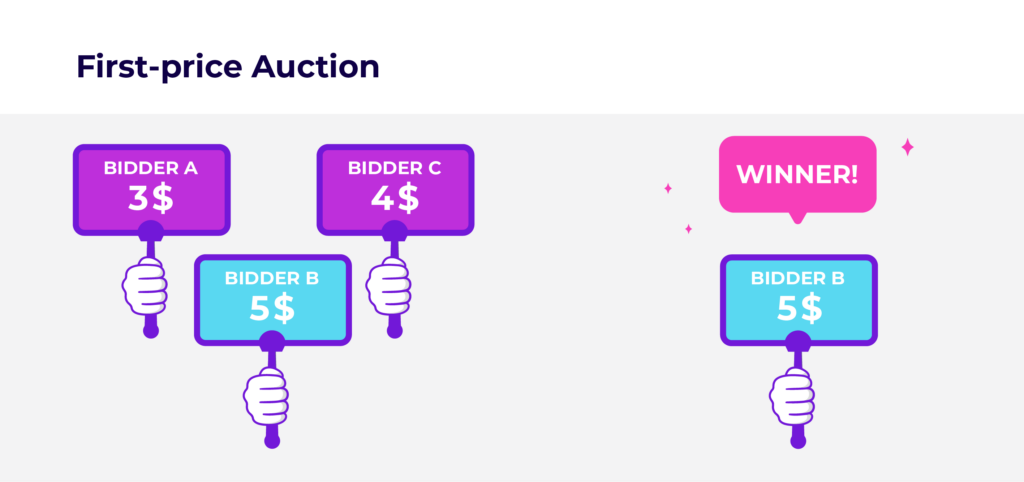
What is the Second-Price Auctions?
In the Second-Price Auction, the highest bidder also wins. How does that work though? Well, the winner typically pays $.01 more than what the 2nd highest bidder offered to pay.
Second-Price Auction Example:
We have three advertisers taking part in the real-time auction. Each of them declares how much they are able to pay for 1000 impressions:
Alex offers $5
John offers $3
Chris offers $4
Alex provides the highest bid again and he is the winner of the auction. Alex will pay the publisher/ad exchange $0,01 more than the second-highest bid – which is $4,01.
The reduction in price for the bid is the difference between what the highest-bidder declared they would pay and the final price per 1000 impressions.
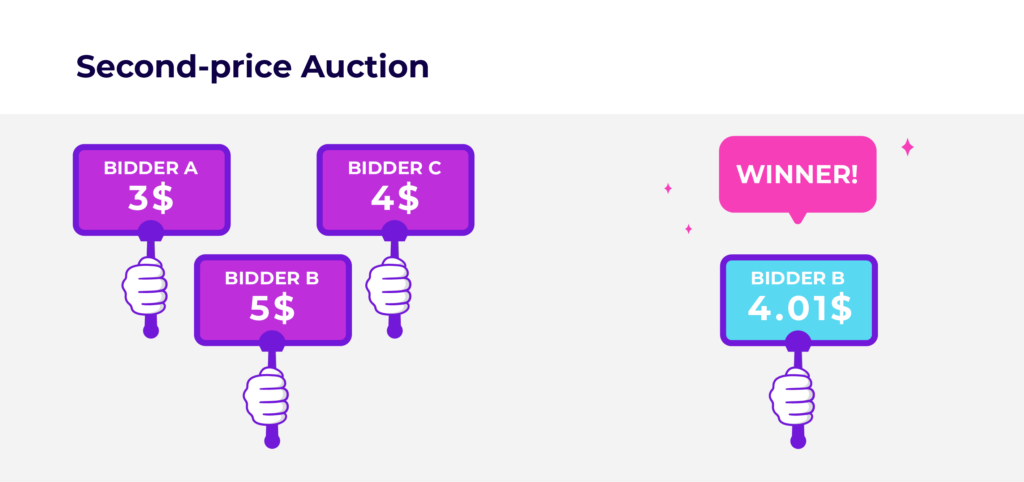
You probably just thought …. OMG isn’t that amazing!? However, everything has its pros and cons, scroll down to find out more!
Aren’t Second-Price Auctions Always Better For the Buyer?
Now, I know what you’re thinking. If you’re an advertiser who’s bidding for traffic, you want the 2nd-price auction method, and if you’re a publisher who’s selling your ad space, you want the 1st-price auction method.
Unfortunately, it’s not that simple. Let’s take a look at an example of header bidding using second price auction:
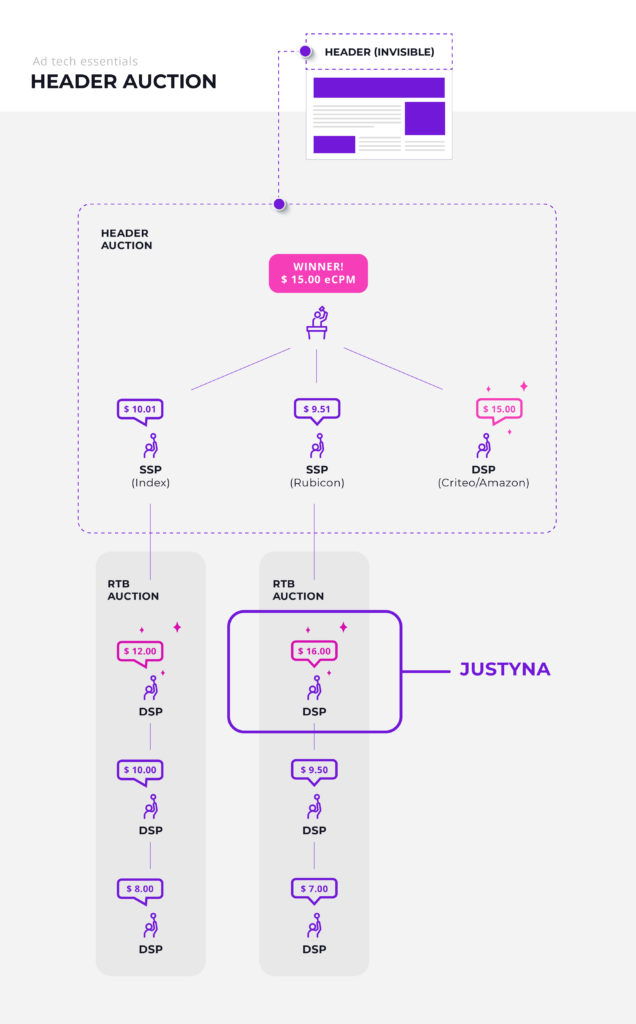
Justyna made a higher bid than the winning bid, but she didn’t win. This is not beneficial for her as the advertiser if she wants this traffic. Why is this happening? In this scenario 2 auctions are taking place.
The first auction is the internal auction in the DSP where Justyna bid $16.00, which she wins because she’s the highest bidder. The second auction is external, between DSPs competing in the auction for the visit from the publisher.
Her DSP works on a second-price auction, so even though she wins, they select the second bidder’s price plus $.01 as the bid for the second auction, thereby bidding $9.51.
Whether the publisher uses a first-price or second-price auction is irrelevant at this point because the highest bidder will still win. Since another DSP bid is $15.00 – which is less than Justyna’s original bid, but more than the bid her DSP used – the other DSP wins.
Most publishers use first-price auction so they can take the $15.00 bid – and the auction is done. As you can see, in this example, both the publisher and the advertiser lose. If Justyna’s DSP used first-price auction and bid with this price, she would have won the traffic and the publisher would have sold the traffic at $1 more.
First-Price Auction Advantages for the Advertisers
The fact you can pay less than you bid per 1000 impressions is very tempting, right? Let us explain what the positive sides are of the First-Price Auction:
- The first-price auction goes great with the header bidding, not only allowing smooth simultaneous bidding, but also more competitive bids.
- Clear financial strategy – the first-price auction allows you to precisely estimate your budget and predict your potential ROI.
- Stop unnatural overbidding – a very popular practice among advertisers using second-price auctions is making an exaggeratedly high bid since they are pretty sure that they will never pay that much even if their bid wins. However, these huge bids can create an unwarranted price increase.
Automatic Bidding Management Strategies with Voluum
Both auction types require using different strategies for placing and managing bids. However, both may benefit from automation that ensures that the optimal bid is placed all the time.
Voluum tracker has a powerful automizer module which, when connected with an API-integrated traffic source, allows to change the bids inside a traffic source using ‘if/then’ logic. This way your bidding strategy will always be up-to-date and reflect the current conditions.
Voluum offers plenty other of features necessary for a native or other advertiser. Give Voluum a try and you won’t regret it!

